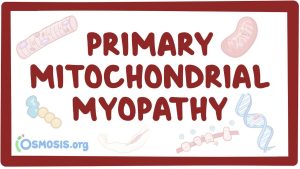What is Mitochondrial Myopathy?
Mitochondrial diseases are caused by defects in mitochondria, which are energy factories found inside almost all the cells in the body. A typical human cell relies on hundreds of mitochondria to meet its energy needs. The symptoms of mitochondrial disease vary, because a person can have a unique mixture of healthy and defective mitochondria, with a unique distribution in the body. In most cases, mitochondrial disease is a multisystem disorder affecting more than one type of cell, tissue, or organ. Mitochondrial diseases that cause prominent muscular problems are called mitochondrial myopathies (“myo” means muscle and “pathos “means disease).
Because muscle and nerve cells have especially high energy needs, muscular and neurological problems are common features of mitochondrial disease. Other frequent complications include impaired vision, cardiac arrhythmia (abnormal heartbeat), diabetes, and stunted growth. Usually, a person with a mitochondrial disease has two or more of these conditions, some of which occur together so regularly that they are grouped into syndromes.
Symptoms:
- Muscle weakness: People with mitochondrial myopathies also may experience muscle weakness and wasting in their arms and legs. Due to the impaired oxidative capacity in skeletal muscle in patients ( from mutations in mitochondrial DNA) this results in limitation in physical capacity that interferes with daily activities and impairs quality of life. Additionally, patients with mitochondrial disease due to mtDNA mutation often live a sedentary lifestyle, which further impair oxidative capacity and exercise tolerance.
- Exercise intolerance: Also called exertional fatigue, refers to unusual feelings of exhaustion brought on by physical exertion. The degree of exercise intolerance varies greatly among individuals. Some people might have trouble only with athletic activities like jogging, while others might experience problems with everyday activities such as walking to the mailbox or lifting a milk carton.
- Muscle Cramps and Pain: Sometimes, mitochondrial disease is associated with muscle cramps. In rare instances it can lead to muscle breakdown and pain after exercise. This breakdown causes leakage of a protein called myoglobin from the muscles into the urine (myoglobinuria). Cramps or myoglobinuria usually occur when someone with exercise intolerance “overdoes it,” and can happen during the overexertion or several hours afterward.
The Benefits of Exercise
Exercise has been shown to improve functional capacity in patients with mitochondrial disease. Whilst it is not a cure, it can greatly improve the quality of life and prevent complications from developing. Some benefits of exercise include:
- Improved energy production in the body
- Improved ability to walk.
- Reduce lactate production
- Reduces the risk of developing some complications which occur most frequently in people with mitochondrial such as diabetes and heart problems.
- Moderate exercise appears to help people with mitochondrial myopathy maintain strength – but overexertion should be avoided.
Since aerobic exercise training increases mitochondrial function and volume density in healthy individuals, studies that found that aerobic training in patients with mtDNA mutation is an efficient way to improve oxidative capacity in this condition, and aerobic training seems to be safe even for patients with high mtDNA mutation in skeletal muscle.
With improved energy production in the body from exercise, it plays an important role in maximising physical health and mitochondrial function. It is important however to exercise within limits and to do it smartly, as sometimes doing too much can onset the symptoms of extreme muscular fatigue, cramping and pain. A tailored, individualised exercise program, completed by an Exercise Physiologist is beneficial, as the right volume and intensity can be prescribed so quality of life and functional capacity can be optimise.
For more information on Mitochondrial myopathy and exercise recommendations; follow the link below.




